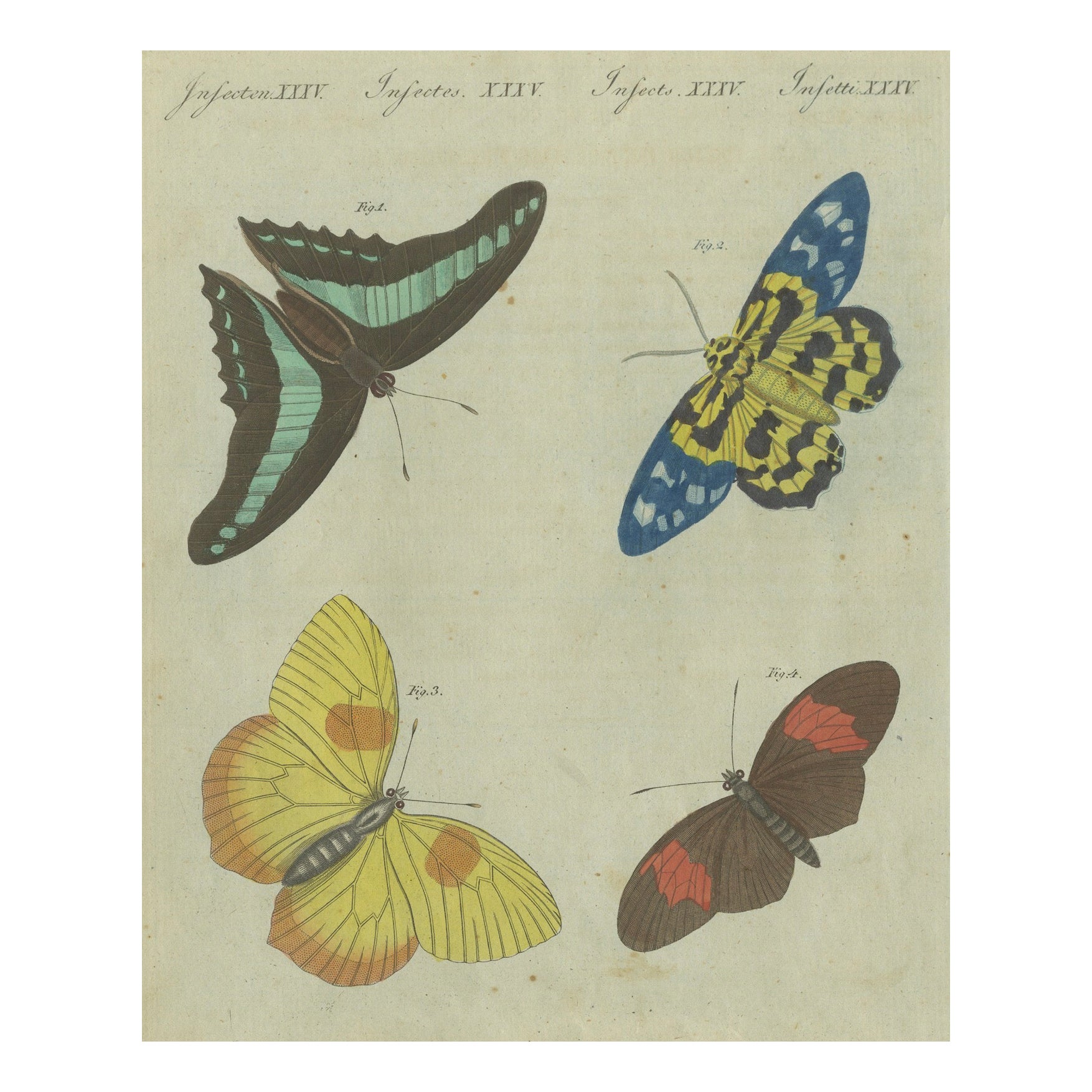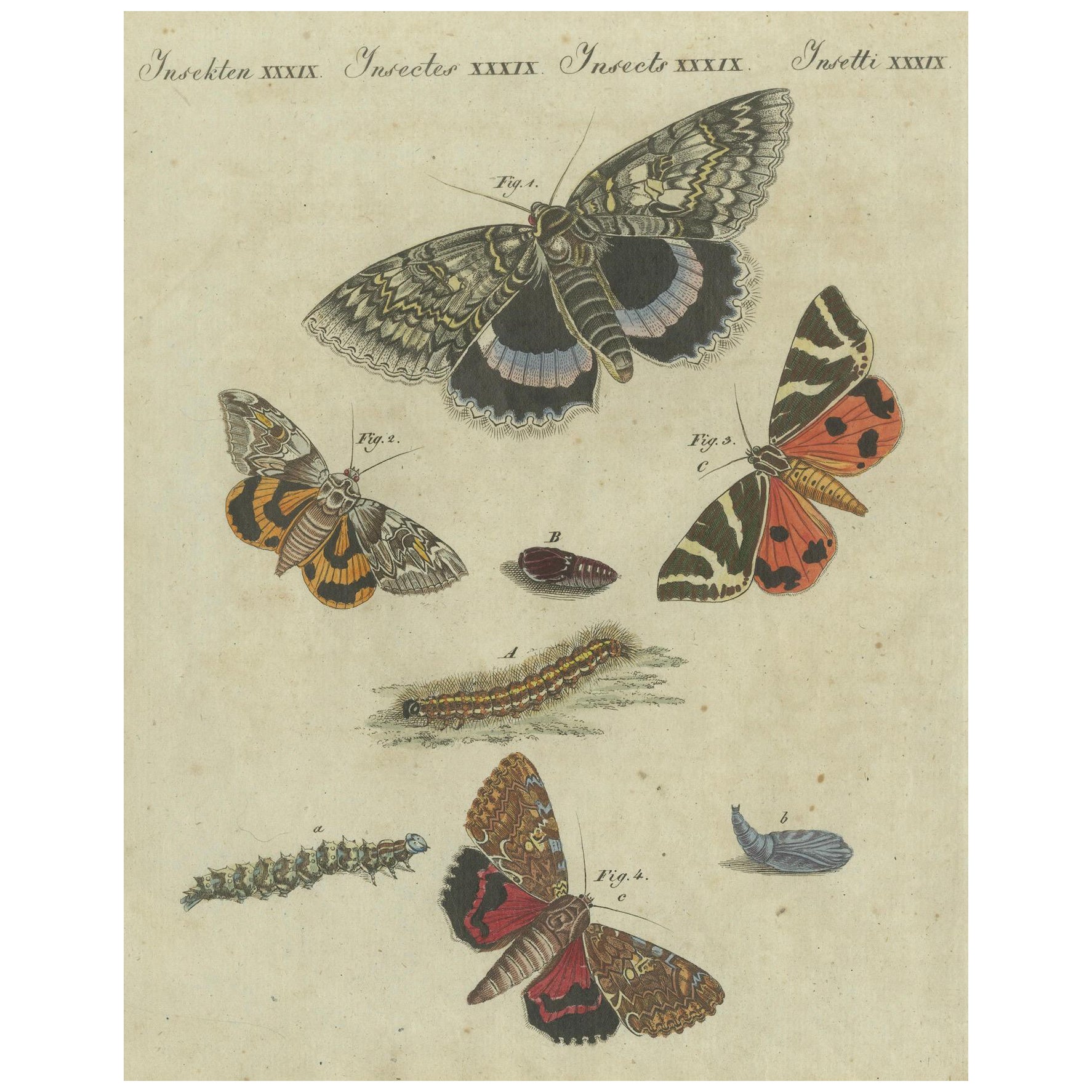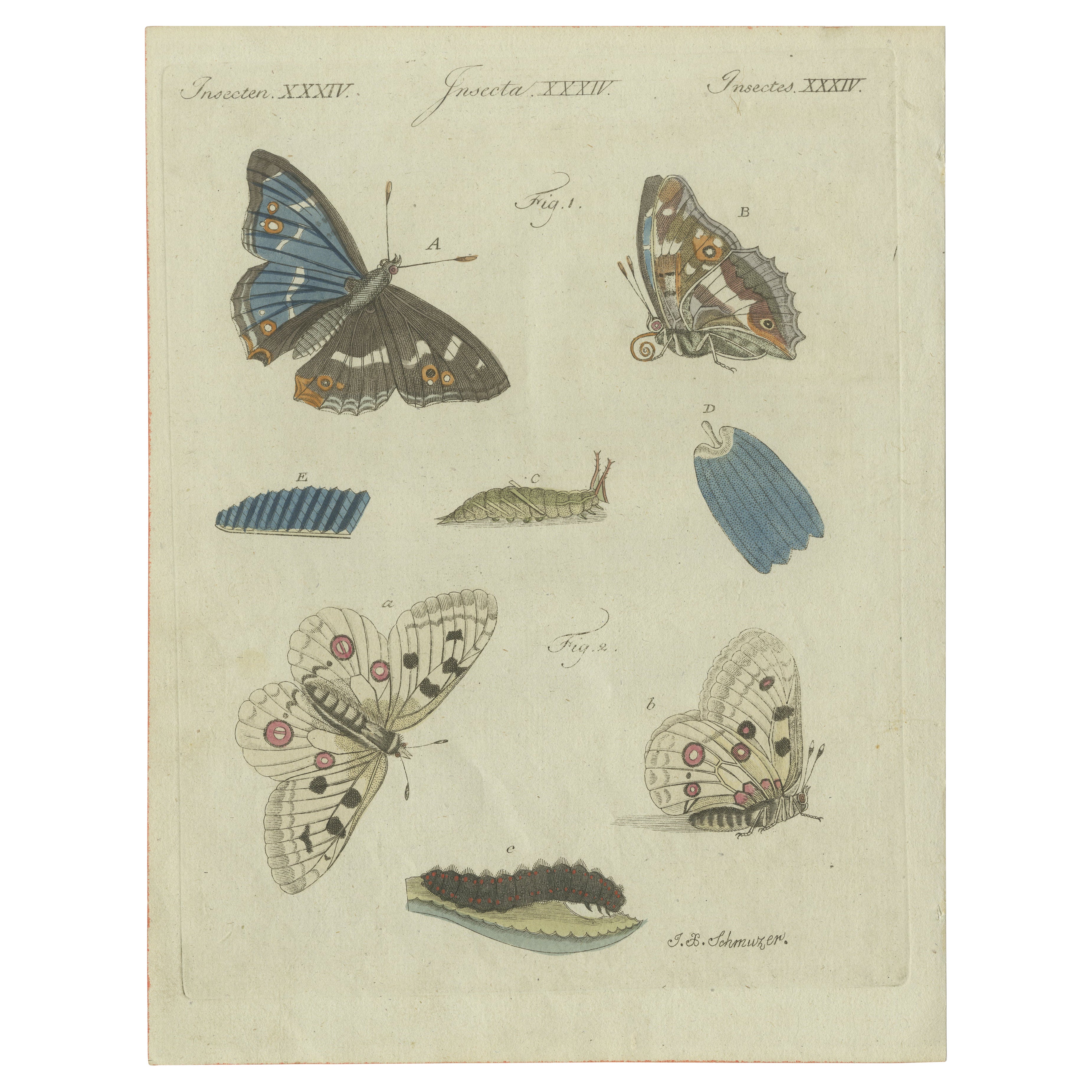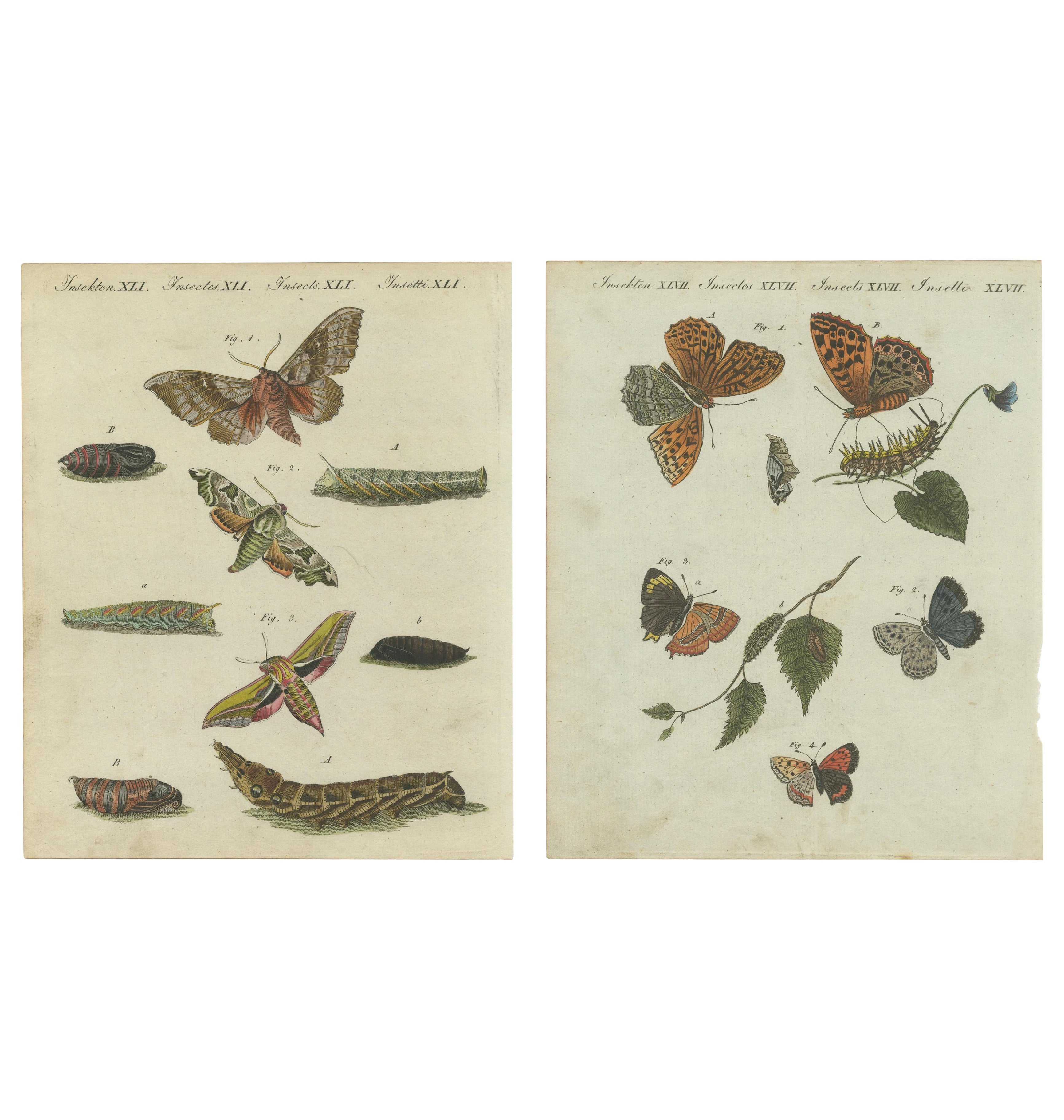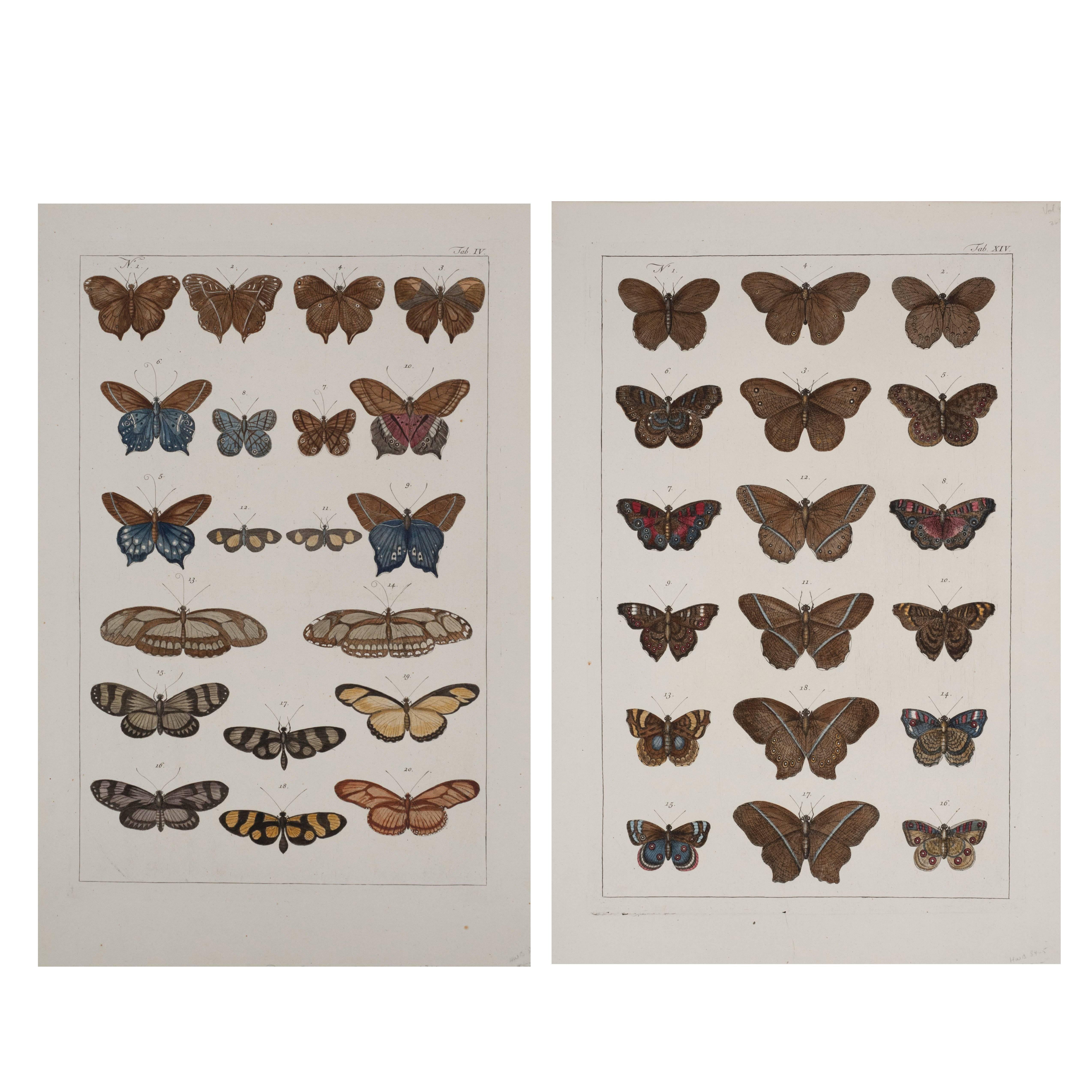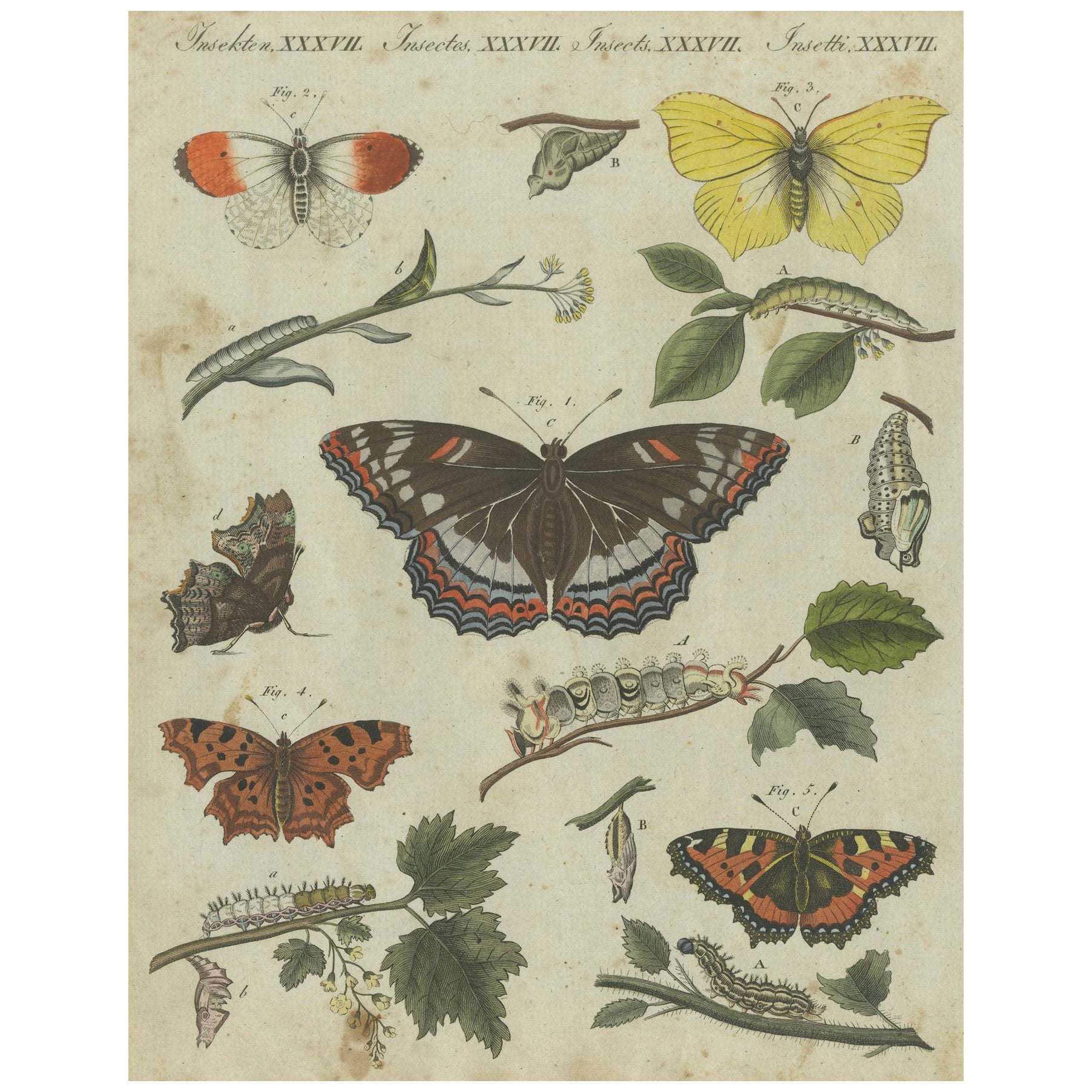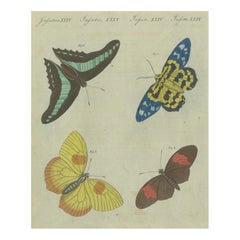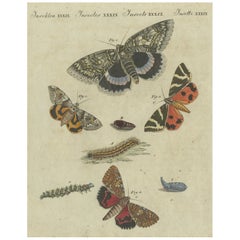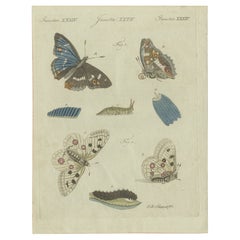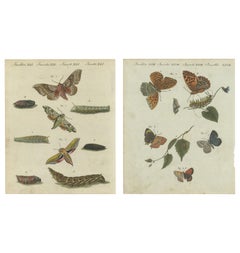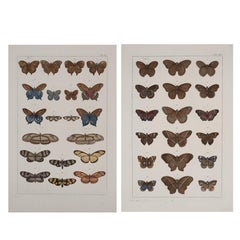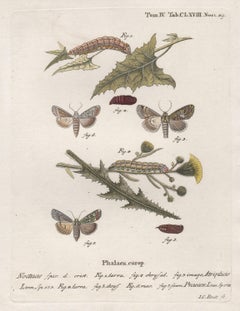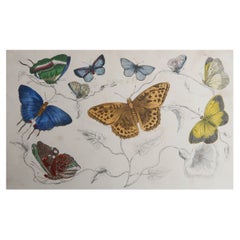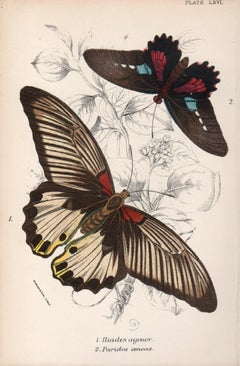Items Similar to Forest Giant Owl Butterfly (Caligo eurilochus) from Suriname, Published in 1802
Want more images or videos?
Request additional images or videos from the seller
1 of 6
Forest Giant Owl Butterfly (Caligo eurilochus) from Suriname, Published in 1802
$86.24
$107.8020% Off
£63.91
£79.8820% Off
€72
€9020% Off
CA$117.73
CA$147.1620% Off
A$130.97
A$163.7120% Off
CHF 68.66
CHF 85.8220% Off
MX$1,600.42
MX$2,000.5320% Off
NOK 874.25
NOK 1,092.8120% Off
SEK 822.99
SEK 1,028.7320% Off
DKK 548.20
DKK 685.2520% Off
Shipping
Retrieving quote...The 1stDibs Promise:
Authenticity Guarantee,
Money-Back Guarantee,
24-Hour Cancellation
About the Item
Title: Forest Giant Owl Butterfly (Caligo eurilochus)
Description: Handcoloured copperplate engraving of the Forest Giant Owl Butterfly, depicting the upperside (figure 2) and underside (figure 1). The butterfly is native to tropical regions, including Suriname, where it thrives in the rich biodiversity of the rainforest.
This detailed artwork showcases the striking eye spots on the wings, a characteristic feature of the species used to deter predators. Taken from Friedrich Johann Bertuch's *Bilderbuch für Kinder* (Picture Book for Children), published in Weimar in 1802, the engraving vividly represents the butterfly's unique coloration and patterns from both perspectives.
The Forest Giant Owl Butterfly (Caligo eurilochus) is fascinating for several reasons:
1. Eye Spots for Defense: The most notable feature of this butterfly is the large, eye-like spots on the underside of its wings. These "owl eyes" resemble those of a predator, which can intimidate and deter potential threats, such as birds. This unique adaptation gives the butterfly an edge in avoiding predation.
2. Crepuscular Behavior: Unlike many other butterfly species that are active during the day, Caligo eurilochus is crepuscular, meaning it is most active during twilight—early morning or late afternoon. This behavior helps it avoid many diurnal predators and makes it a bit of an outlier in the butterfly world.
3. Large Size: These butterflies are quite large, with a wingspan that can reach up to 15 cm (about 6 inches), which makes them one of the largest butterflies in the regions they inhabit. Their sheer size adds to their striking appearance and visual interest, especially when seen gliding through the forest.
4. Mimicry and Camouflage: Besides the prominent eye spots, the wing patterns also have a remarkable ability to blend in with their surroundings. When resting with their wings closed, they often resemble the texture of tree bark or dead leaves, providing excellent camouflage from predators.
5. Host Plant Specificity: The caterpillars of the Caligo species feed primarily on banana and heliconia plants, which are abundant in their native tropical habitats, such as Suriname. This feeding relationship is crucial for local ecosystems and banana plantations, as the butterfly can act as both a pollinator and a potential pest, depending on its life stage.
6. Symbol of Rainforest Diversity: The 'Caligo eurilochus' is a symbol of the rich biodiversity of tropical rainforests. Its presence in areas like Suriname highlights the complex relationships in these ecosystems and the adaptation strategies that tropical species develop to survive and thrive.
These combined characteristics—their defensive adaptations, behavior, size, mimicry, and ecological role—make the Forest Giant Owl Butterfly an intriguing species to both scientists and nature enthusiasts.
Handcoloured engraving from 1802 shows light foxing and minor toning consistent with age. Colors remain vivid, paper edges slightly worn but no major tears or creases. Suitable for framing with care to preserve current condition.
- Dimensions:Height: 9.85 in (25 cm)Width: 7.49 in (19 cm)Depth: 0 in (0.02 mm)
- Materials and Techniques:Paper,Engraved
- Period:
- Date of Manufacture:1802
- Condition:Handcoloured engraving from 1802 shows light foxing and minor toning consistent with age. Colors remain vivid, paper edges slightly worn but no major tears or creases. Suitable for framing with care to preserve current condition.
- Seller Location:Langweer, NL
- Reference Number:Seller: BG-13887-171stDibs: LU3054342445052
About the Seller
5.0
Recognized Seller
These prestigious sellers are industry leaders and represent the highest echelon for item quality and design.
Platinum Seller
Premium sellers with a 4.7+ rating and 24-hour response times
Established in 2009
1stDibs seller since 2017
2,502 sales on 1stDibs
Typical response time: <1 hour
- ShippingRetrieving quote...Shipping from: Langweer, Netherlands
- Return Policy
Authenticity Guarantee
In the unlikely event there’s an issue with an item’s authenticity, contact us within 1 year for a full refund. DetailsMoney-Back Guarantee
If your item is not as described, is damaged in transit, or does not arrive, contact us within 7 days for a full refund. Details24-Hour Cancellation
You have a 24-hour grace period in which to reconsider your purchase, with no questions asked.Vetted Professional Sellers
Our world-class sellers must adhere to strict standards for service and quality, maintaining the integrity of our listings.Price-Match Guarantee
If you find that a seller listed the same item for a lower price elsewhere, we’ll match it.Trusted Global Delivery
Our best-in-class carrier network provides specialized shipping options worldwide, including custom delivery.More From This Seller
View AllExquisite Butterflies and Moths: Vibrant Hand-Colored 19th-Century Engraving
Located in Langweer, NL
Title: A Symphony of Butterflies and Moths: Hand-Colored 19th-Century Engraving from Bertuch’s Bilderbuch für Kinder
Description:
This vibrant hand-colored copperplate engraving...
Category
Antique Early 1800s Prints
Materials
Paper
Vivid Lepidoptera: Hand-Colored 18th-Century Butterfly and Moth Studies
Located in Langweer, NL
This exquisite hand-colored copperplate engraving from Friedrich Johann Bertuch's renowned "Bilderbuch für Kinder" (Picture Book for Children), published in Weimar in 1805, presents ...
Category
Antique Early 1800s Prints
Materials
Paper
18th-Century Hand-Colored Engraving of Butterflies and Larvae by J. B. Schmuzer
Located in Langweer, NL
This hand-colored engraving, titled *Insecta XXXIV*, is a late 18th-century natural history illustration showcasing butterflies and their life stages.
It features two species depic...
Category
Antique 1780s Prints
Materials
Paper
$134 Sale Price
20% Off
Hawk-Moths and Butterflies: Hand-Colored Engravings, Published in 1805
Located in Langweer, NL
The composition of these two hand-colored copperplate engravings presents a visually rich study of moths, butterflies, and their life stages, as published in Friedrich Johann Bertuch...
Category
Antique Early 1800s Prints
Materials
Paper
Exquisite Depiction of Butterflies and Caterpillars: A Hand-Colored Engraving
Located in Langweer, NL
Title: Exquisite Depiction of Butterflies and Caterpillars: A Hand-Colored Natural History Engraving
Description: This beautifully hand-colored copperplate engraving offers a deta...
Category
Antique Early 1800s Prints
Materials
Paper
Unique Entomology Study - Hand-Colored Butterfly Prints Published in ca.1780
Located in Langweer, NL
Hand-Colored 18th Century Butterfly Prints by J.B. Schmutzer - Circa 1775-1790
These beautifully hand-colored engravings, created by J.B. Schmutzer in the late 18th century (circa 1...
Category
Antique 1780s Prints
Materials
Paper
$364 Sale Price / set
20% Off
You May Also Like
Antique Albertus Seba Pair 18th Century Hand-Colored Engravings Butterfly
By Albertus Seba 1
Located in Washington, DC
Rare pair of original hand-colored prints from Sir Albertus Seba's cabinet of natural curiosities. Prints come from published volumes in Amste...
Category
Antique Mid-18th Century Dutch Prints
Materials
Paper
Esper Antique 18th century Butterfly engraving with original hand-colouring
By JC Bock
Located in Melbourne, Victoria
A German copper-line engraving with original hand-colouring of butterflies. Printed on hand made laid paper. Engraved by JC Bock.
From Eugenius Esper's "Die Schmetterlinge in Abbild...
Category
Late 18th Century Naturalistic More Prints
Materials
Engraving
Original Antique Print of Butterflies, 1847, Unframed
Located in St Annes, Lancashire
Great image of butterflies.
Unframed. It gives you the option of perhaps making a set up using your own choice of frames.
Lithograph after Cpt. brown with original hand color.
Pub...
Category
Antique 1840s English Folk Art Prints
Materials
Paper
Butterflies, late 19th century antique natural history colour lithograph
Located in Melbourne, Victoria
'1. Iliades agenor 2. Parides aeneas'
Late 19th century colour lithograph of butterflies.
Category
Late 19th Century Victorian Animal Prints
Materials
Lithograph
Butterflies, English antique natural history Lepidoptera chromolithograph print
Located in Melbourne, Victoria
English butterfly chromolithograph, circa 1900. Plate number top right. From an English series of illustrations of butterflies and moths. Butterflies / moths are numbered and there i...
Category
Early 1900s Art Nouveau Animal Prints
Materials
Lithograph
Peacock Butterfly, Moth & Botanical: An 18th C. Hand-colored M. Harris Engraving
By Moses Harris
Located in Alamo, CA
This is a rare, original first edition hand-colored engraving of Peacock Butterflies and Water Betony Moths depicted in their natural botanical environment, which is plate 8 from Mos...
Category
Mid-18th Century Landscape Prints
Materials
Engraving
More Ways To Browse
Vintage Merry Go Round
Vintage Perfume With Atomizers
Vintage Rubber Ball
Vintage Tea Cups England
White Horse Statue
Widdicomb Burl
Wiener Werkstatte Bronze
Willy Guhl Loop Chair
Wood Horse Statue
Woodard Aluminum
Wrought Iron Chairs Orange
Zeeland Furniture Company
Zen Calligraphy
16th Century Ming Plates
17th Century Teapots
1800 Antique China Cabinet
1870 Carriage
18th Century Jasperware
